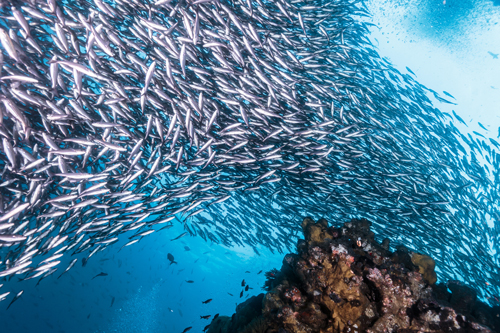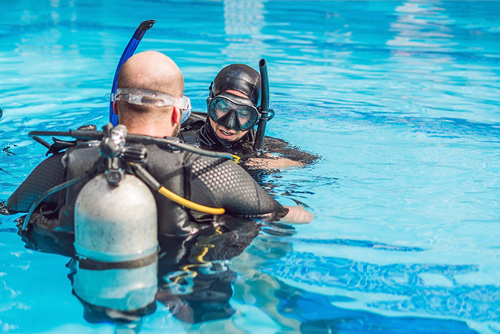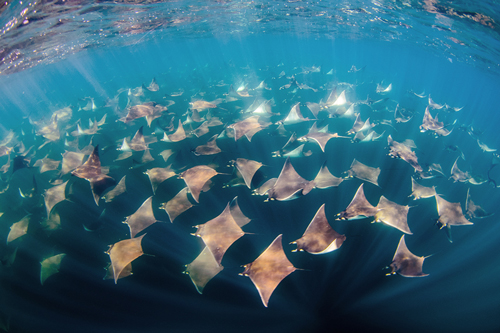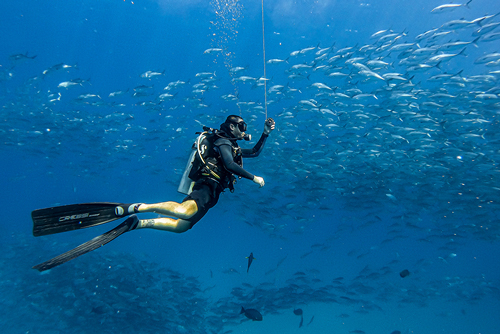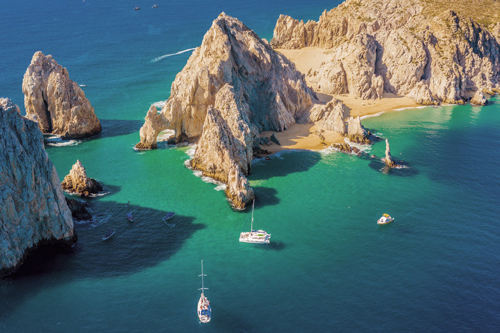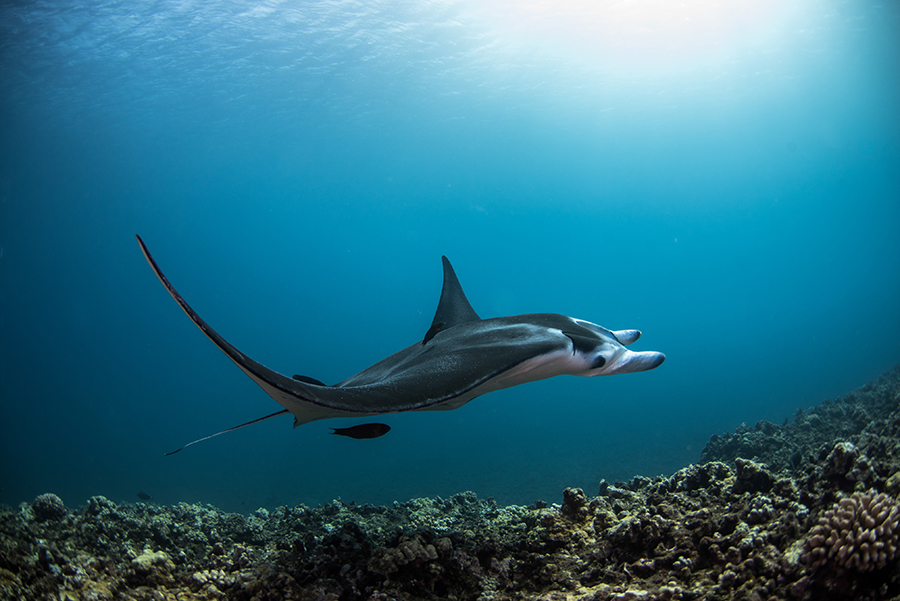Types of rays in Cabo San Lucas
For exceptional diving and snorkeling, Cabo San Lucas is an amazing place, where a huge number of marine species can be found.
Here, in Baja California and the surrounding Los Cabos you can encounter bull sharks, whales, sea lions, hammerheads, whale sharks, but also many different species of rays, such as mobula ray, giant manta , eagle rays or stingrays.
Each species of rays has distinctive features that can help you identify them, let’s see what the most common ray species you can encounter while diving in Cabo San Lucas.
Table of Contents :
Mobula rays
Mobula Rays can be seen in big schools, especially during their migration season. Here at Los Cabos two species of ray belonging to Mobulidae family are commonly seen :
Munk’s Pygmy Devil Ray (Mobula munkiana)
Mobula Munkiana, also called Munk’s devil ray or Pygmy devil ray, is the smallest species of all devil rays, with a maximum length of 3.6 feet. They can be observed during their migration in Cabo from May to August, it is particularly common during the month of July. The top side of the Mobula Munkiana ray is of a lavender to purplish-grey color, while the bottom is white tinged with grey.
Mobula Safari – Jacques Cousteau island

Spinetail Devil Ray (Mobula japanica)
Spinetail Devil Rays are pelagic animals that are found throughout the Indo-Pacific and eastern Atlantic Ocean, but meet in the southern Gulf of Baja California to mate and raise their pups. The Mobula Japonica size reaches a maximum width of 10 feet and while the bottom is white, the back coloration is deep blue with a large black band stretching from eye to eye.
Manta Ray
Nearby Cabo San Lucas, you can encounter 2 main species of Manta Rays, mostly in La Reina Reef, which can be explored off Jacques Cousteau Island (also known as Cerralvo Island):
Oceanic Manta Ray (Mobula birostris)
The Oceanic Manta is the largest type of manta ray that can be encountered in the Sea of Cortez. Mobula Birostris is characterized by a deep dark dorsal surface with a clear T shaped white spot on the head. The maximum disc width of the Oceanic Manta ray can reach up to 30 feet, even though on an average it is around 15 to 16 feet.

Reef Manta Ray (Mobula alfredi)
The Reef Manta ray is the second largest species of manta that can be found around Baja California. Its maximum disc width is 18 feet, but the average common size is of 11 feet. The Mobula Alfredi can be identified thanks to its dark dorsal side with two lighter areas on the head, creating a distinctive “Y” mark.
Jacques Cousteau island diving trip
Eagle ray
While spotted eagle rays or Cownose Ray are not the most common species of ray in these waters. Snorkelers and divers have a good chance to encounter these two species of eagle rays in several Cabos dive sites.
Spotted Eagle Ray
Spotted Eagle rays (Aetobatus narinari)
One of the easiest rays to identify thanks to the unmistakable polka dots pattern on its back, spotted eagle rays are most commonly seen in small groups. Their favorite dive sites around Cabos seems to be The Corridor, but they can be seen swimming and dancing in pairs during their mating season all around the Sea of Cortez.
Cownose Ray (Rhinoptera bonasus)
Often migrating in autumn from the Gulf of Mexico towards Venezuela and Brazil, and back North in late spring, cownose rays can be seen in schools from 5 to 20 specimens around the dive sites of “Lands’ End” and “Neptune’s Finger”. They have a very distinctive shape, with a broad head and two distinctive lobes on its subrostral fin.
Diving Tour : The Corridor of Los Cabos
Cownose Ray
Guitarfish Rays
Guitarfish Rays are often found in the surroundings of Cabo San Lucas. We see them mostly from April to June, with lower water temperatures, while diving in the Cabo San Lucas dive site “Neptune’s Finger”. They love burying themselves under the sand for camouflage.
Banded Guitarfish (Zapteryx exasperata)
The Banded Guitarfish with a maximum total length of 4 feet, are characterized by a diamond shaped body with dark grey to sand brown coloration, with typical black or brown banding on their back which give them their name. Banded Guitarfish can also be known as Prickly Skates due to the rough texture of their skin, caused by prickles or spiked throughout their dorsal surface.

Shovelnose guitarfish (Rhinobatos productus)
A little over 3 feet and with their protruding dorsal fin shape, shovelnose guitarfish have been often mistaken for sharks. They are known for their extremely well developed visual system, as the entire dorsal and ventral surface is connected to it and has multiple projections sent to the brain at the same time.
Diving tour : Cabo San Lucas Bay
Electric rays
Torpediniformes, or electric rays, are characterized by a rounder body and their impressive electric organs. Electric rays can be spotted in shallow coastal waters around Los Cabos.

Bullseye electric ray (Diplobatis ommata)
Bullseye electric ray is a small type of Torpediniformes also called ocellated electric ray, from the Latin oculus, due to its distinctive eye spot – or bullseye – right in the middle of its dorsal disc. Bullseye electric ray’s maximum recorded length is only 9.9 inches, and it can be seen mostly during night dives as it is naturally solitary and nocturnal. It’s highly ornated pattern makes it easy to identify.
Giant electric ray /Cortez electric ray (Narcine entemedor)
The Giant electric ray as per the name, this is a pretty big sized electric ray, reaching a maximum length of 30 inches. It belongs to the family of numbfish, known for delivering quite painful shocks, and can be found in shallow waters on sandy bottoms. Also known as Cortez electric rays, they have a greyish or brown coloration, a little darker towards the tips, with white sidelines.
Stingrays
Last but not least, a few types of stingrays inhabit the sea floor of Baja California. Stingray are characterized by their venomous spinal blades, rarely fatal their sting can be nonetheless painful.

Blue spotted stingray (Taeniura lymma)
A dive photographer favorite, the blue spotted stingray is very comfortable in coral reef associated habitats. Its size is quite small, especially when compared to other stingrays, as it can reach a maximum width of 14 inches. Blue Spotted Stingray is easy to recognize thanks to its large protruding eyes, its oval pectoral fin disc, but mostly because of its distinctive coloration: electric blue dots on a yellow background.

Cortez Round Stingray (Urobatis maculatus)
Cortez Stingray or Spotted Round Ray, is a species of ray that is endemic to Mexico and particularly to the Sea of Cortez. It lives in shallow seas, coastal lagoons and marshes, and can reach a maximum length of 17 inches, which poses it at high risk for captivity. Interestingly, due to its smooth olive colored body with dark brown patterns, it is also called chocolate chip ray.
Q&A : Types of Rays in Cabo San Lucas
What is the difference between Stingray / Eagle ray / Manta?
Stingray, Eagle Ray and Manta Ray are separate species of Elasmobranchii, they are cartilaginous fishes (Chondrichthyes).
- Stingrays have a stinging spinal blade positioned mid-tail, which can secrete venom causing serious injuries to animals or humans.
- Eagle rays have a distinctive diamond shaped body and pointy mouth, like the beak of an eagle.
- Manta rays are characterized by large triangular pectoral fins, and cephalic fins around their mouths. Manta ray are extremely elegant and graceful, despite the large size.
Are Stingrays Dangerous?
The stinger carry on the stingray tail is definitely no joke. These venomous spinal blades can inflict serious injuries or even be lethal in certain cases. The best way to avoid any issue with stingray is to control our interactions with these creatures, avoiding any sudden movement that might scare them off. Diving while maintaining good buoyancy will help you to enjoy a safe encounter with stingray. If you do not feel comfortable with your buoyancy do not hesitate to ask for a PADI refresher before your dive, or perform a Peak Performance Buoyancy specialty course.

Keep reading
Want to know more about marine life in Baja California and species identification ? :


